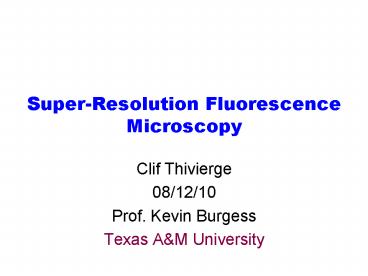Super-Resolution Fluorescence Microscopy - PowerPoint PPT Presentation
1 / 31
Title:
Super-Resolution Fluorescence Microscopy
Description:
Super-Resolution Fluorescence Microscopy Clif Thivierge 08/12/10 Prof. Kevin Burgess Texas A&M University The Bane of Imaging: Diffraction Limit practical limit ... – PowerPoint PPT presentation
Number of Views:746
Avg rating:3.0/5.0
Title: Super-Resolution Fluorescence Microscopy
1
Super-Resolution Fluorescence Microscopy
- Clif Thivierge
- 08/12/10
- Prof. Kevin Burgess
- Texas AM University
2
The Bane of Imaging Diffraction Limit
- practical limit obtained when imaging very small
objects by magnification - diffraction causes blurring of objects when
imaging smaller than 200-500 nm (diffraction
limit) - broadening of a point caused by diffraction is
known as the point spread function (?) - ?x-y? (0.61 ??/(? sin(?))
- ? refractive index medium
- ? half-cone angle of focused light
3
Examples of Diffraction Limit
4
Ways to Circumvent Limit
- Near Field Microscopy (NSOM)
- Far Field Microscopy
- Confocal, 4pi and I5M, SIM
- Super-Resolution
- Spatially Patterned Excitation
- STED
- RESOLFT
- SSIM
- Localization Methods
- STORM
- PALM
- FPALM
5
Near Field Imaging (NSOM)
- -place microscope distance less than 1 wavelength
from sample - -20-50 nm resolution
- problem cannot image into sample because of
wavelength restriction
6
Far Field Confocal Microscopy
- Non-linear 2-photon excitation and pinhole
detection decrease SPF beyond classical limits - 21/2 improvement in resolution
- problem 2-photon excitation uses high
wavelengths which increase SPF - ?x-y? (0.61 ??/(? sin(?))
7
Structured-Illumination Micropscopy (SIM)
100 nm resolution possible
8
Conclusions
- methods use common dyes (good)
- confocal is easiest, most widely used
- best resolution obtainable only 100 nm (SIM)
- single molecule is problematic
9
Super-Resolution Microscopy
- Goal obtain sub-100 nm resolution
- pioneered by Stefan Hell in mid-1990s
- Max Plank Institute (Germany)
- two methods
- Spatially Patterned Excitation
- STED, RESOLFT, SSIM
- (ii) Localization Methods
- STORM, PALM, FPALM
10
Stimulated Emission Depletion Microscopy (STED)
- Spontaneous VS Stimulated Emission
when an excited molecule encounters a photon
matching its emission energy, another clone
photon is created and ground state results
11
STED
- sample is excited with laser and blur is obtained
due to diffraction (?exc) - another doughnut shaped laser excites at
emission wavelength (?STED) of dye and switches
outside dyes to dark state - observing in between ?exc and ?STED, very resoved
image is produced
12
STED Microscopy
resolutions 20 - 30 nm common, best 6 nm
13
STED Dyes
-dyes need to be very photostable excitation
laser 107 W/cm2 STED laser 109 W/cm2 -dye
needs large stimulated emission
cross-section -most common Atto 532 and Atto
647N Rhodamine derivatives?
14
Dyes Used for STED
15
Reversible Saturable Optically Linear
Fluorescence Transitions (RESOLFTs)
same concept as STED but dyes are made to dark
state by other mechanisms -switch to triplet
state -switch to ground state -use reversibly
photoswitchable dyes advantages -less
powerful lasers need to be used (100
W/cm2) -this leads to many more dyes and even
fluorescent proteins being used
16
Single Molecule Imaging
the exact location of single dyes can be
determined by doing multiple excitation/emission
cycles
17
Things Become More Complicated with Multiple Dyes
Considerable overlap. Hard to identify individual
fluors in real live.
18
Super-Resolution Single Molecule Localization
Methods
- Stochastic Optical Reconstruction Microscopy
(STORM) - Photoactivated Localization Microscopy (PALM)
- Fluorescence Photoactivated Localization
Microscopy (FPALM) - all work by same principle image only some dyes
at one time
19
Consider Previous Example
Considerable overlap. Hard to identify individual
fluors in real live.
20
Most Dyes in Off-state
localization of on-state dyes possible
21
Switch the State of the Dyes
localization of other dyes possible
22
Combine the Images
position of each dye is known
23
Dyes for Localization Microscopy
- have on and off state
- easily able to switch from on/off state
- on/off can be non-fluorescent or have a change in
either excitation or emission wavelengths - best if reversible but not necessary
24
Common Dyes for Localization Mic.
25
Examples of Photoswitchable Dyes
26
Conclusions on Localization Microscopy
- using this technique 3D localization of labels
can be achieved with 20 nm resolution
27
Multicolor Imaging
methods discussed so far are valuable in the
elucidation of structures to study interactions,
multicolor imaging can be used multicolor
imaging has been done with both STED and
Localization Microscopy
28
Multicolor STED
- 2 methods
- (i) use set of dyes with non-overlapping
excitation, emission, and STED wavelengths (hard
to find) - (ii) find dyes with same STED excitation but
non-overlapping absorbance
29
Multicolor STED Synaptic Proteins
Synaptophysin (red) Syntaxin 1 (green)
30
Conclusions
- still very young technology and best dyes have
yet to be discovered - impact is big since imaging is such a popular
tool - a lot of opportunity for innovation/development
31
The End






























